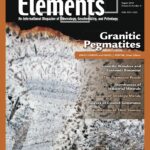
Granitic Pegmatites, August 2012, Vol. 8, No. 4
June 28, 2024
Kaolin, June 2014, Vol. 10, No. 3
June 28, 2024One Hundred Years Of Isotope Geochronology, February 2013, Vol. 9, No. 1
$20.00
In 1913, Frederick Soddy’s research on the fundamentals of radioactivity led to the discovery of “isotopes.” That same year, Arthur Holmes published his now famous booklet The Age of the Earth.
One Hundred Years Of Isotope Geochronology
February 2013, Vol. 9, No. 1
In 1913, Frederick Soddy’s research on the fundamentals of radioactivity led to the discovery of “isotopes.” That same year, Arthur Holmes published his now famous booklet The Age of the Earth. Combined, these two landmark events established the field of science we know as “isotope geochronology.” Today, isotope geochronology underpins much of our knowledge of the absolute age of minerals and rocks, and the records they contain. This field is constantly evolving, reflecting and responding to scientific drivers that require more highly resolved timescales, the microscopic analysis of smaller zoned minerals, or the generation of robust data sets in novel materials. This series of articles provides perspectives on the state of the art in the field of radioisotope dating—from the challenges of dating the Solar System’s oldest materials to resolving the record of Quaternary climate change, and the four and a half billion years in between.
Why You’ll Love Elements Magazine:
- Expert Contributors: Articles written by renowned researchers in the field of geoscience.
- Engaging Content: Join a community of readers who are passionate about Elements.
- Exceptional Quality: Each issue is printed on high-quality paper with stunning visuals and detailed illustrations that bring complex scientific concepts to life.
Order your copy of the February 2013 issue of Elements magazine today and learn about one hundred years of isotope geochronology.
Related products
-
Frontiers In Textural And Microgeochemical Analysis, August 2007, Vol. 3, No. 4
$20.00Recent advances have been made in high-resolution in situ methods to image mineral growth patterns, analyse compositional and isotopic zonation, and improve our ability to visualize, study, and model rock textures in three dimensions. These advances provide a significant step forward in the understanding of how rocks form and the history they can tell us.
-
Early Earth, August 2006, Vol. 2, No. 4
$20.00The earliest Earth was a strange inhospitable world, yet transitions occurred culminating in the evolution of life within the first billion years. The preservation of a sparse and ambiguous rock record has encouraged debate.
-
On The Cutting Edge: Teaching Mineralogy, Petrology, And Geochemistry, April 2007, Vol. 3, No. 2
$20.00New advances in research on learning have important implications for teaching mineralogy, petrology, and geochemistry. Effective instructional practices are increasingly student centered, address diverse student learning styles, and employ a variety of active-learning strategies.




